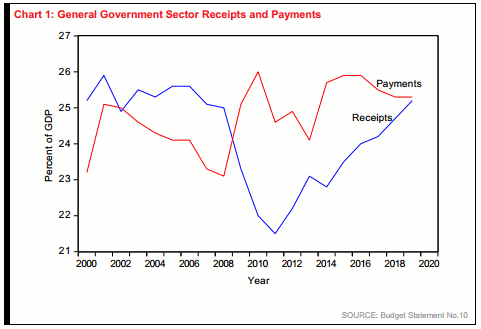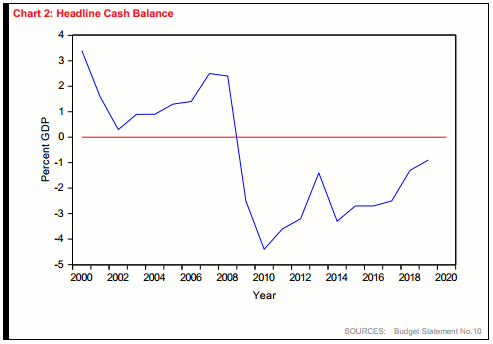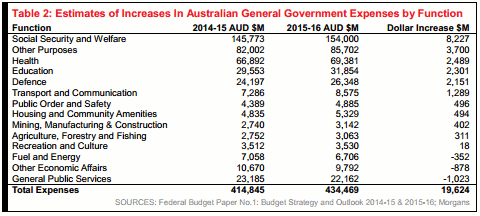This time last year, we noted that the budget was one of pretend austerity. Much of the debate following the budget then pretended that the austerity was real. It was not real austerity then and it is not real austerity now. In Chart 1 below, drawn from Statement No.10 page 6, we see the payments of the budget as a percent of GDP. Last year the budget was for year 2014/15.
In that year, payments grew to 25.9% of GDP. This was UP from 25.7% of GDP the year before.

The current budget year is 2015/16. Payments are again expected to be 25.9% of GDP in this budget year. There is only a mild decline in outlays in the next three years. Payments ease to 25.5% of GDP in 2016/17. They further ease to 25.3% of GDP in 2017/18. Payments then remain stable at 25.3% of GDP in 2018/19. If last year is a guide, this stability in expenditure will come to be attacked as cruel and unfeeling austerity.
At the same time though, the budget deficit is being addressed. Revenue is expected to grow.
In 2014/15 revenue is expected to be 23.5% of GDP. This should grow to 24.0% of GDP in 2015/16. Revenue should recover in 2016/17 to 24.2% of GDP. It should grow further in 2017/18 to 24.7% of GDP. In 2018/19 revenue should rise further to 25.2% of GDP. This process of stable spending and rising revenue moves to reduce the deficit.
In Chart 2 we see the improvement in the General Government Cash Balance. As well as payments, the cash balance includes net cash flows from investments in financial assets. This gives us a slightly different result than the simple difference between receipts and payments. In 2014/15, the headline cash deficit was 2.7% of GDP. In 2015/16 the headline cash balance should remain at 2.7% of GDP. However, in future years the deficit declines.
This deficit should fall to 1.3% of GDP in 2017/18. It should decline again to 0.9% of GDP in 2018/19.
This kind of decline should be enough to stabilize Australia’s sovereign debt relative to the size of Australian GDP.

Where is the money going?
In Table 1 below, we see the outlays in this budget and the sectors where the money is being spent. The total outlays under this budget are $434.5 billion. By far the biggest area of expenditure is on Social Security and Welfare. Expenditure here is 35.4% of the budget. Total spending on Social Security and Welfare is $154 billion. This is more than twice the level of spending on Health. Health spending is $69.4 billion. This is 16% of the budget. Education, the next in line, sees spending of $31.8 billion. This is 7.3% of the budget.
Defence, the next significant sector, sees spending of $22.2 billion. This is 5.1% of the budget.
We note that spending on Social Security in this budget is around seven times spending on Defence. Housing and Community Amenities sees spending of $8.6 billion. This is 2% of the budget. Public Order and Safety sees spending of $4.9 billion or 1.1% of the budget.

In Table 2 we see the increases in budget sectors. The largest increase is in Social Security and Welfare where spending rises by $8.2 billion. I can’t wait for the Senate Debate in which this increase in Social Security and Welfare spending is attacked as austerity. Increase in health spending are the next largest. Health spending sees a rise in outlays of $2.5 billion.
Education sees the next largest increase of $2.3 billion. Defence sees the next largest rise of $2.2 billion. Public order and safety sees a rise of $496 million.

Growing Jobs
This is one of the few budgets were a lot really happens in the Budget Speech. Everybody knows that most employment is created by small business. This budget really does seek to provide incentives for the expansion of small business. This must inevitably support employment growth.
The first incentive is to reduce the company tax rate on companies with annual turnover of less than $2 million. From 1 July, the company tax rate will fall from 30% to 28.5%. For those small businesses that are not incorporated, there will be a 5% tax discount of up to $1,000 per year.
The real incentive for small businesses is 100% accelerated depreciation allowances. In simple terms, small business can receive an immediate tax deduction for each and every item they purchase up to $20,000. The objective is to increase investment in the 96% of Australian businesses that have turnover of less than $2 million per year. This means that every item, including cars, kitchens or machinery will receive this accelerated depreciation allowance.
The government will also abolish fringe benefits tax on all portable electronic devices like mobile phones, laptops and tablets. The government will also expand the tax concessions for employee share schemes. Employees will not have to pay tax on their shares until they actually receive a financial benefit from those shares. All of these initiatives should speed jobs growth in the small business sector.
The Economic Outlook
Compared to the recent outlook provided by the RBA, the Treasury outlook appears almost optimistic. GDP growth is still a somber 2.5% in 2014/15. Still, it rises to 2.75% in 2015/16. It then rises again to 3.25% in 2016/17. The result of this acceleration in growth is that employment rises from 1.5% in 2014/15 and 1.5% again in 2015/16 to 2% in 2016/17. This allows unemployment to rise slightly to 6.5% in 2015/16. Unemployment then declines to 6.25% in 2016/17.
Wages growth is relatively slow and stable. Wages should grow by 2.5% in 2014/15. They should grow again by 2.5% in 2015/16. This wages growth should rise slightly to 2.75% in 2016/17.
Conclusion
This budget keeps outlays steady. At the same time, the budget provides support to the small business sector. The objective is to support small business employment growth.
Should things go well, the economy will recover and rising tax receipts will reduce the deficit.
We hope that things go well.
This article was first published in Morgan’s Economic Strategy.